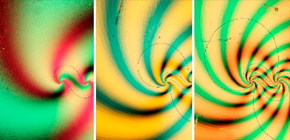
Success in controlling the number and shapes of topological defects in liquid crystals
May lead to development of new liquid crystal devices
Electrical, Electronic, and Information Engineering, Graduate School of Engineering, Osaka University -- YOSHIDA Hiroyuki (Assistant Professor), ASAKURA Keita (Student in the master's program in 2014-2015), OZAKI Masanori (Professor);
Dynamic Functional Mateials Group, Functional Chemistry Research Department, Advanced Industrial Science and Technology (AIST) -- FUKUDA Jun-ichi (Chief researcher)
A group of researchers from Osaka University and AIST developed technology for controlling the number and shapes of topological defects in nematic liquid crystal film and demonstrated that objects measuring a couple of microns could be reversibly operated by a low voltage of 2V or less by making use of topological defects they had created. Nematic liquid crystal is an intermediate phase between solid and liquid made up of rod-like molecules, and is a common liquid crystal material for displays. Topological defects in liquid crystals have been drawing attention as one way of expanding possibilities of their use other than display -- creating gel capable of repairing itself and producing a special light wave called an "optical vortex"; however, it had not been easy to control their number and shapes. Although liquid crystal has become synonymous with televisions, many materials show liquid crystalline state, such as functional high molecule materials used for bulletproof vests, organic semiconductors used for solar batteries, and biological samples such as DNA, for example. Since this group's technology for controlling the number and shapes of topological defects can be used for all types of materials, it will contribute to applications in a wide range of areas.
Abstract
Topological defects in liquid crystals not only affect the optical and rheological properties of the host, but can also act as scaffolds in which to trap nano or micro-sized colloidal objects.
The creation of complex defect shapes, however, often involved confining the liquid crystals in curved geometries or adding complex-shaped colloidal objects, which is unsuitable for device applications. Through the use of topologically patterned substrates, we demonstrate the controlled generation of three-dimensional defect lines with non-trivial shapes and even chirality, in a flat slab of nematic liquid crystal. By using the defect lines as templates, colloidal superstructures are constructed, which, by exploiting the electrical response of liquid crystals, can be reversibly reconfigured by a voltage as low as 1.3 V. Three-dimensional engineering of the defect shapes in liquid crystals is potentially useful in the fabrication of self-healing composites and in stabilizing artificial frustrated phases.

Fig. 1 Topological defects with controlled shapes and numbers.
When a nematic liquid crystal is sandwiched between two substrates possessing orientational patterns with a singular point, topological defect lines, observed as thin black threads, are generated between the two pattern centers. The number of the topological defect lines is controlled by the ‘strength’ of the singular point on the pattern, while their shapes are controlled by the liquid crystal orientation surrounding the singular point.
Fig. 2 Schematic of a nematic liquid crystal with unidirectional alignment (left) and a singular point in the alignment (right).
Topological defects are singular points in the liquid crystal orientation, and exist either as points or lines in three-dimensional space.

Fig. 3 Schematic of orientational patterns containing a singular point and liquid crystal textures observed experimentally
In the streamline plots presented in the upper row, liquid crystal alignment is imposed along the streamlines. A nematic liquid crystal cell is then assembled from two substrates possessing the same patterns. When the pattern centers are co-aligned, liquid crystal textures reflecting each design are observed under a polarizing optical microscope.

Fig. 4 Generation of topological defects with controlled shapes and numbers.
When a nematic liquid crystal is sandwiched between two substrates possessing orientational patterns with a singular point, topological defect lines, observed as thin black threads, are generated between the two pattern centers. The number of the topological defect lines is controlled by the ‘strength’of the singular point on the pattern, while their shapes are controlled by the liquid crystal orientation surrounding the singular point.

Fig. 5 Control of micro-sized particles using topological defects
Colloidal particles introduced in liquid crystals can be positioned three-dimensionally as they are trapped by the topological defect lines, which exist three-dimensionally within the liquid crystal cell. The defect lines change their shape in response to a small voltage of less than 2 V, and induces a shift in the positions of the particles. The change in position occurs three-dimensionally and is reversible.
To learn more about this research, please view the full research report entitled “ Three-dimensional positioning and control of colloidal objects utilizing engineered liquid crystalline defect networks ” at this page of the Nature Communications website.
Related links
